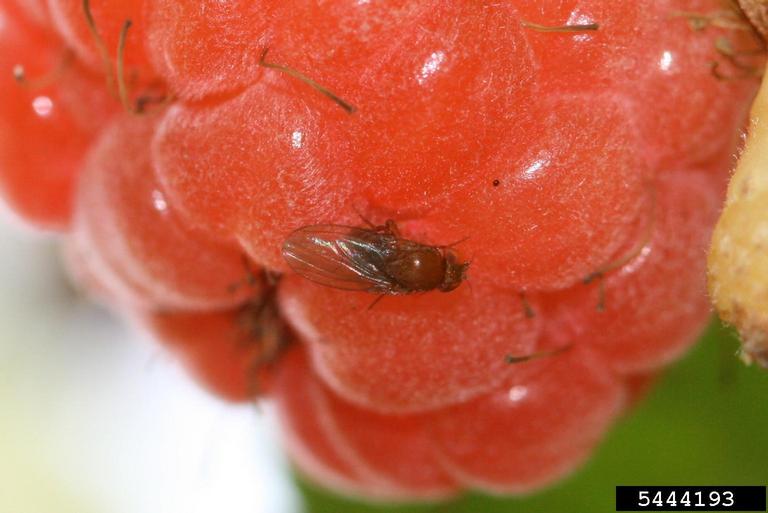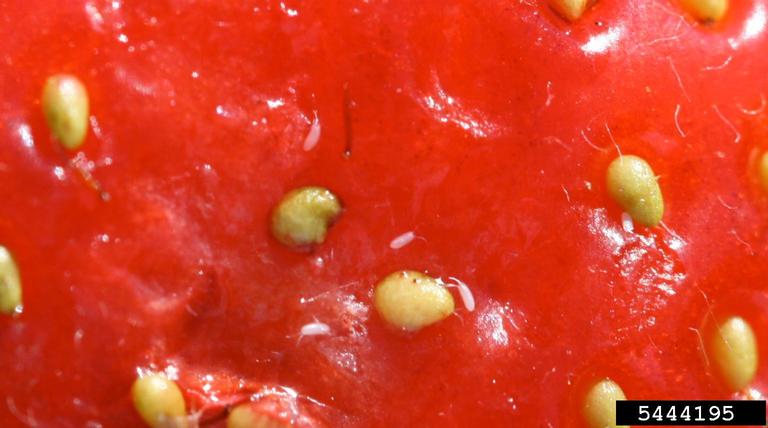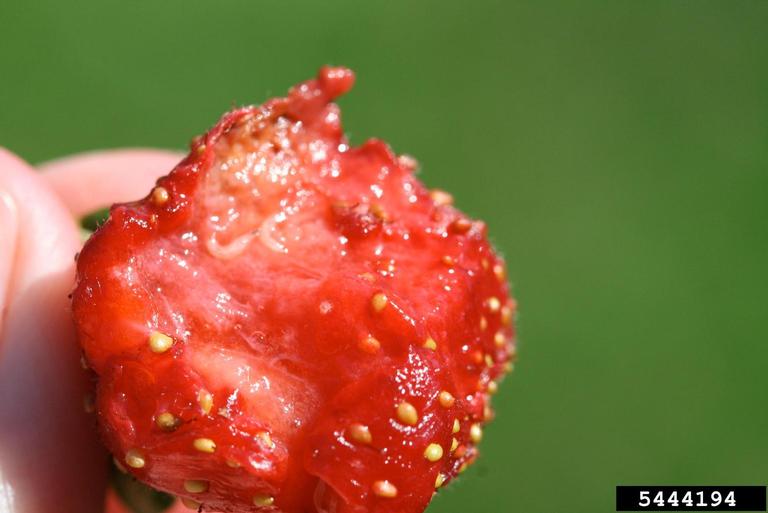 |
Female spotted wing drosophila and damage on raspberry fruit (Rubus). H. Burrack, NCSU, Bugwood.org
|
The spotted wing drosophila (SWD), Drosophila suzukii, is a small fruit fly (vinegar fly) native to Japan. It was first discovered in the western United States in 2008 and has quickly moved through the Pacific Northwest into other parts of the US and northward into Canada. It has been reported in Illinois and Missouri. It is a serious pest of most berry crops, cherries, grapes and other tree fruits, with a preference for softer-fleshed fruit, such as raspberries, blackberries, strawberries and blueberries. Unlike most fruit flies it lays eggs in undamaged, healthy fruit as well as damaged or rotting fruit. (Other species lay eggs only in already-damaged and rotting fruit.) The adult flies have been transported by man far and wide.
Symptoms and Diagnosis
Adult male flies are only 1/16 to 1/8 inch long and have red eyes. They have two distinctive dots on the wings (females do not have the wing spots). Male flies also have two dark bands on the forelegs. On the female SWD, the large serrated ovipositor is a distinctive morphological feature, longer than other fruit and vinegar fly species and with two rows of serrations.
Infested fruit do not show obvious symptoms of infestation at first with only a small pin-prick visible from egg-laying. Within a few days, however, the fruit flesh will start to break down leading to discolored regions and eventual collapse of the tissues. By this point, the white larvae, about 1/8 inch long, can be relatively easy to detect. By being able to insert eggs into healthy, undamaged fruit the larvae of SWD can be present during ripening on the plant but only detected after harvest. During egg-laying, sour rot and fungal diseases can also be introduced, further affecting fruit quality. There is a greater risk of fruit contamination at harvest from SWD compared with native species that lay eggs only in already-damaged and rotting fruit.
Life Cycle
Adults live about two weeks to over a month depending upon climatic conditions and can lay more than 100 eggs a day. In Missouri they will complete multiple generations a year. This demonstrates their high potential for fruit infestation and spreading if not controlled. Females cut into intact fruit using their serrated ovipositor to insert 1-2 eggs under the skin. The larvae (maggots) hatch in a few days and begin feeding. The maggots pupate either on the fruit, or fall to the ground, where they emerge as adults. A complete life cycle can take between 10-20 days.
Integrated Pest Management Strategies
1. Practice strict sanitation. Collect and dispose of any and all damaged and fallen fruit. Do not compost. Place in a sealed plastic bag to prevent adults from emerging and dispose in the trash. Also, keep the surrounding area free of weed host plants, such as, wild blackberries and other plants with soft fruit that could harbor the pest. Increase air circulation around plants as SWD prefers sheltered areas with high humidity as in dense foliage cover.
2. Harvest early. Harvest fruit when it first begins to turn color and allow the fruit to ripen off the plant reducing its attractiveness to the fruit fly.
3. Exclude adult flies. The use of very fine netting (less than 0.98 mm, 18 mesh or finer) applied before the fruit starts to begin to ripen can exclude the adults. Be sure and apply before the first fruit start to ripen or flies can be trapped inside the netting. Exclusion, however, can have the adverse effect of excluding pollinators from crops, such as, everbearing strawberries.
4. Use insecticides. Sprays of spinosad, malathion or pyrethrins can be effective if applied early before adult females have laid eggs in the fruit. Some resistance to natural pyrethrins has been noted. Malathion is very toxic to bees and natural predators. Make sure the crop you are spraying is listed on the pesticide label and follow all directions including those for the waiting time before the crop can be harvested. SWD prefers high humidity so will be found in dense foliage areas. Good coverage is essential to be effective.
For effective pesticide timing, commercial growers pair chemical controls with traps used for monitoring pest presence and levels.
Ongoing research can be followed on the Michigan State University website.
Organic Strategies
Strategies 1, 2, and 3 are strictly organic approaches. Spinosad and pyrethrin are organic pesticide choices listed in Strategy 4. Consult the Organic Materials Review Institute (OMRI™) for more information.
More images:
 |
Male spotted wing drosophila on trap, showing spotted wings. H. Burrack, NCSU, Bugwood.org
|
|

|
Female spotted wing drosophila on raspberry fruit (Rubus). Note lack of spotted wings on female. H. Burrack, NCSU, Bugwood.org
|
|

|
Tiny, white cigar-shaped eggs of the spotted wing drosophila on strawberry fruit (Fragaria x ananassa 'Duchesne ex Rozier'). H. Burrack, NCSU, Bugwood.org
|
|

|
White c-shaped larvae of the spotted wing drosophila on strawberry fruit (Fragaria x ananassa 'Albion'). H. Burrack, NCSU, Bugwood.org
|
|